Jordan Wright
November 15, 2013
Special to DC Metro Theater Arts, Broadway Stars, and LocalKicks
Cedar’s Aaron McCloud Creates Amazing Dishes with Olives from Spain
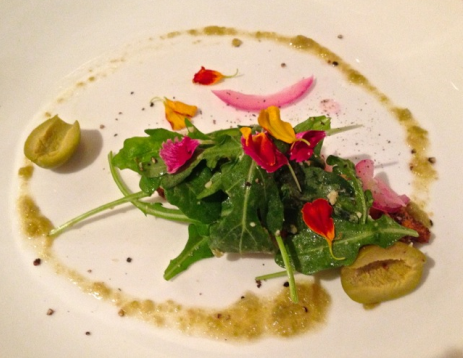 Olive salad at Cedar Restaurant As one of eight U.S. chefs selected to highlight the use of Spanish olives in their cuisine by Olives From Spain, Cedar’s Executive Chef Aaron McCloud staged a spectacular five-course luncheon last week using recipes he devised and pairing the dishes with Spanish wines. Among the other well-known chefs chosen are Seamus Mullen of New York City’s Tertulia; Michael Kornick, Chef/Owner of Chicago’s mk; Ethan Stowell, of Seattle’s Staple & Fancy and Anchovies & Olives; and Giorgio Rapicavoli of Miami’s Eating House. The concept was to show how non-Spanish chefs and home cooks can incorporate Spanish table olives into their recipes. Throughout the season McCloud will be featuring some of these dishes on Cedar’s menu.
McCloud, who gave up studying classical violin with Itzhak Perlman for a life behind the scenes, hails from Michigan and brings with him a farmer’s keen sense of natural ingredients in his approach to cooking.
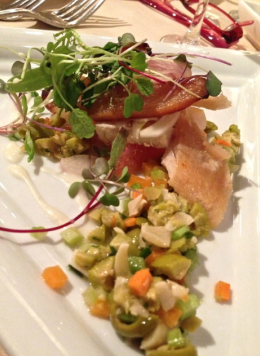 Smoked trout with Meyer lemon and olive relish At a luncheon last week the chef started the meal with a delicately crafted salad of spiced walnuts, arugula, Gordal olives, Manchego cheese and decorated the plate with nasturtiums. Our second course was smoked trout with pickled fennel, grapefruit supremes, preserved Meyer lemon and olive relish which was followed by Merino lamb loins crusted with olive powder and placed in a tart of olives with pickled royal trumpet mushrooms. Spanish Gordal olives made a second appearance stuffed into a roulade of wild boar loin and served with an olive salad and heirloom tomato salad dressed with bacon and olive vinaigrette.
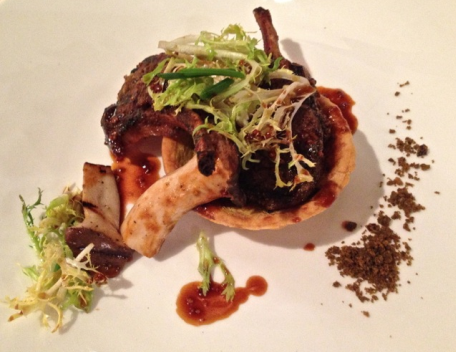 Merino lamb with olive powder and pickled Royal trumpet mushrooms Proving the versatility of the olive with meats isn’t as tricky as it is with sweets. But McCloud overcame the challenge by using the milder type of uncured black olives in a silky panna cotta. The smooth egg-less custard was enhanced with a sweet herb “soup” of made from pineapple sage, lemon verbena and sugar and cooked down to a light syrup and poured over the dish at table and served with a white chocolate olive cookie. McCloud explained, “I decided to make a cookie and thought of substituting the olives for the usual raisins.” Sliced almonds spiced with cardamom, cinnamon, fennel seed and cumin, and baked with maple syrup, provided the unique dessert with a delectable crunchiness. So delectable in fact that I secured the recipe along with a cache to take home.
www.CedarDC.com. And for more information on Spanish olives visit www.OlivesfromSpain.US.
Go With the FLO, Baby
 Jazz Master Marcus Johnson at FLO Wines party What pairs best with wine and friends? Why, jazz of course. So say DC-raised Contemporary Jazz Keyboardist virtuoso Marcus Johnson and his partner Winemaker and Co-Founder Rob Piziali. FLO stands for “For the love of…” and there was a lot of love flowing from the top floor of Georgetown’s chic Puro Café last week when the pair debuted their gently priced Red Blend, Chardonnay and 2011 Moscato wines, all of which are produced and bottled in Napa Valley’s St. Helena. Though the company was launched only a year ago, the popular wines can already be found around our area in stores like Costco, Wal-Mart, Target, Giant, Whole Foods, Harris Teeter, Total Wine and Farm Fresh, and hotels like Marriott and Four Seasons Hotel Washington, DC.
While guests enjoyed nibbles and sips Johnson tickled the ivories for his rapt fans – – one of whom won a lavish gift basket chockfull of gourmet goodies and bottles of FLO Wine. The company has teamed up with Thankfully Yours, a DC-based company, to create festive wine and food gift baskets for the holidays.
Johnson, a Billboard “Top 10” and NAACP Image Award-nominated jazz musician with 15 studio albums to his credit, will be at Blues Alley Jazz Club from December 12th to the 16th.
Visit www.FLOBrands.com to learn more about upcoming wine events in the area. To order their gorgeous gift baskets go to www.ThankfullyYours.com.
A Master Class in Brazilian Wines at DC’s Fogo de Chao
Coming from a family who bought a coffee plantation in Brazil on a whim, I can’t say I ever imagined in my wildest dreams I would be sitting among experts drinking fine wines from Brazil. But that’s what I was doing last week along with area buyers, wine consultants, fellow writers and local sommeliers at a large U-shaped banquet table in DC’s Fogo de Chao restaurant. A dizzying array of fifteen wines and thirteen “churrasco” style barbecued meats were served while Master Sommelier and Wine Educator, Evan Goldstein, kept the enthusiastic sippers engaged with a power point presentation of the regions of Brazil and the development of its industry.
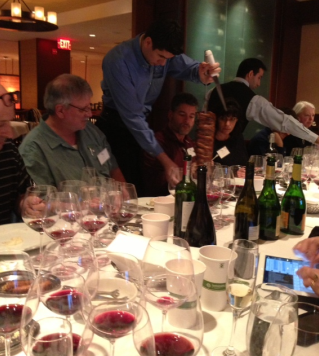 Brazilian wines and churrasco at Fogo de Chao After first reminding us that no less a wine connoisseur than British journalist and wine merchant Steven Spurrier (responsible for the legendary “Judgment of Paris”) had lauded Brazilian wines this year in an article featured in Decanter magazine, Goldstein urged us to begin with a delicate rose-colored sparkler before tasting more serious wines whose grapes are picked from vines brought to Brazil from early Italian and Portuguese settlers who arrived in the country in 1551.
One of the more intriguing factoids about the region’s wines is that Brazil has two harvest seasons every year. By applying a product called Dormex, growers can encourage early ripening that results in two seasons of picking grapes.
There are five dominant wine-growing regions in Brazil, though currently only three have certifications of origin. The main regions are Santa Catarina, Serra Gaucha, Serra do Sudeste and Campanha in the Southern region of the country, and Vale do Sao Francisco in the Northeastern Region near Bahia. Serra Gaucha is considered the most important and largest wine region within Rio Grande do Sul.
We sampled a 2009 Cave Geisse Terroir Nature, a glamorous sparkler made by Maurice Geisse, a Chilean winemaker who once worked for the house of Moet & Chandon and who is now using his considerable talents at his family’s vineyard in the Serra Gaucha region. But an appealing parvenu nipped at its heels. Retailing at half its price, Casa Valduga Brut 130 is a sassy sparkling wine once lauded by former French President Nicolas Sarkozy during a visit to Brazil.
As we progressed to the still whites, I was surprised to hear that Moscatos and Chardonnays dominate the whites. In fact Lidio Carraro Dadivas Chardonnay is made by fifth generation Italians and has been chosen as the “Official Wine of the World Cup”.
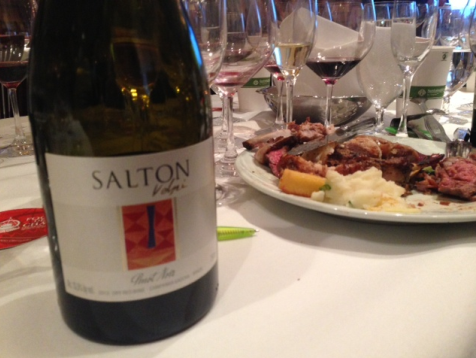 The stellar Salton Pinot Noir Here are the wines that stole my heart and they were all reds. Salton Pinot Noir 2012 (young yet, but holding distinct promise); Salton Desego 2008, a Merlot aged in 50-50 French and American Oak; Perini Marselan 2010, another youthful vintage with the unusual cross of Cabernet Sauvignon and Grenache from a vineyard dating back to the 1870’s; Lidio Carraro, Quorum, a pricey Merlot, Cab, Tannat and Cab Franc blend from 2006; and Pizzato CONCENTUS 2007, a knockout at $25.00.
Look for these at www.FogodeChao.com
Iron Gate – History Restored
The much-anticipated opening of Iron Gate on N Street turned into one the most fabulous private gatherings for a restaurant opening ever. While many guests reminisced about their dining experiences in days past, there was no one present that could have said they were there when it was opened in 1923 by the General Federation of Women’s Clubs. The group whose headquarters are in another historic building next door, is still the Iron Gate’s landlord. To this day the Federation Director’s private residence overlooks the restaurant’s garden from atop the third story.
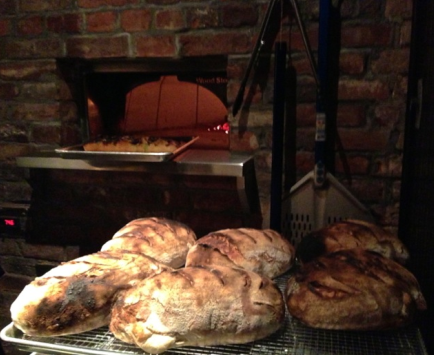 The wood fire oven at Iron Gate For those who may have dined here before the restoration slash remodel, the surprise will be an enclosed and two-story dining space and bar area inside the restaurant’s elegant carriageway. The entrance is now dominated by magnificent lead-framed windows that rise two stories up to meet the building’s original keystones. Iron lanterns, and a pair of repurposed chandeliers retrieved from an old theatre in Baltimore, light the old brick walls. In the bar a massive walnut-framed mirror that was discovered in a garage in Silver Spring, overlooks the 10-seat bar. The large bricked garden, adorned with century old wisteria and still-producing grapevines, sports an electronic awning for inclement weather. A romantic aura fills the main dining area where dark wainscoating, flickering candlelight and a roaring fireplace lend an air of charming intimacy.
The style of cuisine is drawn from the traditional dishes of Greece, Sicily and Sardinia with a menu arranged by category – “Garden”, “Water” and “Pasture”. Diners make their selection from a four- or six-course menu (with or without wine pairings). Some items are available a la carte at the bar or on the patio. Leading a trio of seasoned and award-winning professionals is noted Chef Tony Chittum who left Vermillion in Alexandria’s Old Town to showcase his creativity in this beautiful space. He is flanked by Mixologist Jeff Faile, formerly of Casa Luca and Fiola, and Wine Director Brent Kroll, formerly of Adour at the St. Regis.
At the friends and family opening, plates were piled high with everything from spit-roasted pig, broccoli bruschetta bright with house-made ricotta and garnished with a tiny sardine. Crispy sunchokes with yogurt dipping sauce and light-as-a-feather veal sweetbreads were delectable treats as were the grilled fennel sausages that had an insinuating way of demanding repeat attention. I loved an Ouzo Punch, made with rosemary, ouzo and Galliano. I haven’t seen Galliano in a cocktail since “Golden Cadillacs”, made with the herb-infused yellow Italian liqueur, crème de cacao and cream, were all the rage.
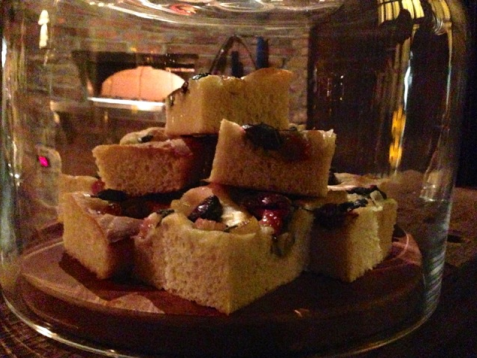 Sweet things await at Iron Gate The sweets were playful – Campari marshmallows, loukamades, hot from the oven and dripping with orange blossom glaze, and Sicilian pistachio buckeyes coated in chocolate. Sheer ambrosia.
With classic architecture, intriguing history, celebrated chef, gorgeous garden, fireplace, separate bar, intimate dining room and sidewalk patio, Iron Gate is truly dressed to impress. www.IronGateRestaurantDC.com
Photos by Jordan Wright
Jordan Wright
October 28, 2013
Special to DC Metro Theater Arts, Broadway Stars, and LocalKicks
Frenchifying Fairfax, The Gin Game Redux, J&G Steakhouse Adds a Secret Room, the Day of the Dead Comes Back to Life and Olive You Too, Espana!
Frenchifying Fairfax
If you blink you’ll pass the modest storefront of Le Mediterranean Bistro, a mere slip of a place in historic Fairfax City, Virginia that quiets down towards nightfall. Once inside the cozy bistro senses prick up. You might detect a whiff of foie gras lightly searing with brandy, lobster carapaces creating a rich seafood stock or lamb shanks braising in wine and herbs. The room is filled with the aroma of tarragon, thyme, rosemary and lavender – – the floral notes of the Midi. But wait! There’s more. Exotic spices like saffron, cinnamon and cardamom intermingle with traditional French herbs – – a clue to Chef/Owner Driss Zahidi’s Moroccan roots.
 In the kitchen of Le Mediterranean Cafe with Chef Owner Driss Zahidi The 50-seat spot is already bursting at the seams. Last month there were lines outside and tables were filled with diners looking as blissful as Cheshire cats. The décor is simple but welcoming. Warm pumpkin-colored walls, linen covered tables and a few large contemporary paintings in a room dominated by a chalkboard announcing the evening’s food and wine specials.
 The cozy atmosphere at Le Mediterranean Cafe Leading off with the most decadent dish on the menu might not seem like a wise beginning, but would you pass up pan-seared diver scallop and steamed lobster topped with foie gras and bathed in black truffle sauce? I think not, fellow gourmands. It’s already made my top ten dishes of the year.
A roasted beet salad with creamy goat cheese and Cara Cara orange sections hit all the right smoky-tangy notes, before moving on to into seafood paella and osso bucco. The paella served in its own pan had baby clams, artichoke hearts, scallops, lobster (Can one ever say no to more lobster?), shrimp, mussels and bits of spicy chorizo. Billowy clouds of steam rose off the dish and its saffron scented rice. An imposing portion of braised lamb shanks, falling-off-the-bone tender, was served atop fluffy cous cous, perfect for absorbing the meaty wine-infused juices on the bottom of the earthenware casserole. Each dish we tried showed the hand of an experienced chef, one who understands French country classics while celebrating his own country’s contributions.
 The heavenly seafood bouillabaisse – Lobster, scallop and foie gras with black truffle sauce at Le Mediterranean Cafe Dessert is made in-house and you can’t go wrong with the apple tarte tatin a la mode, aswirl in caramel sauce or the last-of-the-summer peach cake with a foil of piquant raspberry coulis.
As for service, it was swift and polite. Each table in the small room seemed to get the same friendly attention. As for me, I reveled in the cheerful, well-orchestrated atmosphere that makes it feel like a private party. Reservations recommended.
The Gin Game Redux
 The patio at New Heights Recently I took a stroll down memory lane and into Woodley Park. It’s been moons since I’d been to New Heights, a restaurant that’s launched more successful chefs than NASA has launched rockets, most notably – Cahal Armstrong, Brian McPherson, RJ Cooper, Ron Tanaka, John Wabeck, Logan Cox and Matthew Lake. Cutting edge dishes are de rigeur in this friendly neighborhood watering hole that overlooks Rock Creek Park.
Lately 25-year old Takeshi Nishikawa, a Japanese chef straight off a stint in Bryan Voltaggio’s Volt and earlier positions at Restaurant Eve and the now shuttered Maestro, three of the area’s most lauded kitchens, has taken the helm. Nishikawa has already put a thrilling new menu together combining some unusual ingredients and sophisticated techniques to showcase his talents and experience. From ginger and cardamom to highlight a carrot soup, beech mushrooms and eggplant paired with veal sweetbreads, and goat cheese tortellini served with pickled ramps and morels, the young chef is playing with food and thinking out of the box. Farro makes an appearance beside locally raised rack of lamb and halibut gets polenta and pearl onions. Expect the unexpected.
Owner Umbi Singh, an dashing fellow with impeccable manners, has been letting young chefs have their say in his kitchen for twenty-seven years, but lately he’s turned over the reins at the bar to Nicole Hassoum, a sprightly, and wildly inventive, mixologist who has transformed the small space into her own private laboratory. It’s called The Gin Joint and it’s a temple to gin in its many forms.
 Cocktail wizard Nicole Hassoum at The Gin Joint Over 45 gins from around the planet go into her cocktails. From dry gins, Old Raj from Scotland and Leopold’s of Denver; to spicy, Botanist from Islay to Green Hat, a DC distillery, to Silver Tip from Montana. Citrus flavors are a separate category and range from the juniper flavored Greylock from the Berkshire Mountains of Massachusetts, to Damrak from Amsterdam, described as showing floral as well as blood orange notes. Two more categories define alternate profiles. More floral still are Citadelle from France revealing jasmine, honeysuckle and cinnamon, and Darnley’s View from Great Britain with overtones of elderflower. The final grouping includes Ransom “Old Tom” from Oregon, a revival gin once made in the 19th C, and Smooth Ambler Barrel Aged from West Virginia, a gin with aromas of orange, caramel and spice.
Adding to the “mix” Hassoum makes her own tonic. Seven different kinds, if you will. Crazy cool combinations like citrus cucumber, pummelo passionfruit, basil fennel, and hibiscus saffron. Using these and other ingredients sourced from the kitchen, this adorable mad scientist has invented an extensive cocktail menu to show off her seemingly unlimited imagination. I tiptoed around, choosing my target like a thief in the night, before selecting the “Filibuster” made with Jensen’s gin, heirloom tomato water, Lillet Blanc and basil. The ultimate in gin bliss which harkened me back to an afternoon utterly misspent in a garden in the English countryside. Visit her to be transported back to your own gin memories.
J&G Steakhouse Adds a Secret Room
 The dining room at the recently renovated J&G Steakhouse in the W Hotel One of the most gorgeously contemporary designs in a dining room in Washington, DC surely has to be J&G Steakhouse in the W Hotel. After a summer shutdown, the restaurant has blossomed into a stunning space with the addition of Bar 515 beside a wall-length banquette in the dining room where guests can see and be seen. It’s got my vote for the most luxuriously chic and sophisticated décor in town.
Decorated in a dramatic palette of charcoal grey, silver and lipstick red the high-ceilinged room, surrounded by huge Palladian windows and massive columns that run the length of the room, has given Jean-George Vongerichten a perfectly sophisticated setting in which to flaunt his not-so-very-French dishes.
Anyone for a 12-ounce cut of Akaushi beef, or a 32-ounce pork porterhouse? It’s here. In the seafood category there’s fried calamari with pickled beet tartar sauce and jumbo lump crab cakes. Pretty standard bar food elsewhere – – done here with finesse. Grilled Loch Duart salmon, a farmed fish from northern Scotland, and Chesapeake Bay rockfish enhanced with mushroom dashi and Swiss chard, all rang my bell.
But I confess I’m most partial to two of the appetizers – – the beef carpaccio on flatbread and the yellow fin tuna tartare served with a tangy fennel mignonette and topped with toasted quinoa. Imagine those with a dry martini made tableside by a roving bartender with a rolling bar cart and you’ve got the picture.
My favorite niche is off the dining room down a flight of stairs where a sexy-cool secret bar has been created out of a former storage space. It’s lit mostly with candles and is so darkly intimate that on my recent visit I couldn’t get a proper photo of it. Take my word for it. The bar leads out onto a spacious patio where you can pose attractively under umbrellas while watching the swells go by. A lovely place to dream a little dream.
The Day of the Dead Comes Back to Life
 The Pato Borracho “Drunken Duck” cocktail for the Day of the Dead celebration – A typical seviche – Making guacamole in the expanded dining room and bar at Oyamel That the Mexican Day of the Dead celebration coincides with Halloween is music to the ears of all things that go bump in the night – – though the pre-Columbians got the jump on the Halloween inventing Celts by about 500 years. At Oyamel drinks and dishes have been created to honor Jose Guadalupe Posada, a turn of the century artist and political cartoonist best known for his satirical skeleton illustrations called calaveras.
In a preview last week I had the chance to taste all four specialty cocktails, Resucito – Maestro Dobel Diamond Tequila, Cochi Americano Rosa, lime leaf and grapefruit bitters; Cempasuchil – House-infused lavender Pueblo Viejo Blanco Tequila, Crème Yvette, mint and lemon; Pato Borracho (drunken duck!) – house-infused duck Gran Centenario Anejo, Chihuatl chile, pomegranate and pineapple with almond air; and Atole Rico – Del Maguey Crema de Mezcal, Pueblo Viejo Tequila, house made atole, canela, piloncillo, vanilla, pineapple and lemon.
In addition to their regular menu Executive Chef Colin King has come up with five delicious new dishes. Caviar de Chapala – with carp roe, Serrano peppers and green tomatoes in chochoyotes (a kind of dumpling); Ostiones Pimenton – oysters poached with bay leaf and garlic and served in their shells with a touch of lime and caviar; Pato Frito en Chile Seco – crispy Hudson Valley duck leg with Chihuatl mole, locally foraged mushrooms, kabocha squash and served with pomegranate pico de gallo; Chichilo Negro – slow-cooked short ribs with mole negro and vegetables; Sopa de Calabaza – pumpkin and squash soup with spiced pumpkin seeds, chile and annatto oil and served with foie gras. Have I got your attention now?
King worked with famous cookbook author Diana Kennedy often cited as the “Queen of Mexican Cuisine” to, as he put it, “Advance the traditional and authentic dishes of the many regions of Mexico with an eye towards innovation.”
Olive You Too, Espana
 Gathering featuring nibbles by Jose Andres Our dear friend, José Andrés, the most famous Spanish chef in America, has launched a new line of foods from his homeland called José Andrés Foods. Recently I served some of these delicacies at a small gathering in my home. Some of the products may sound familiar to you, others may seem mundane, but I assure you they are not ordinary. The sardines are tiny fish, not the broken and halved sort found in today’s supermarkets, full of bones and packed in cheap vegetable oil. These were delicate and the oil was first-rate. We loved the Mussels in ‘Escabeche’ that I served atop Pa de Pagès, rustic Catalan toast slices that proved to be a perfect perch for any topping, including super ripe tomatoes.
Rounding out the nibbles were Andrés’ thinly sliced potato chips and Gordal and Hojiblanca olives. The new line of foods from Andres includes white tuna in olive oil, razor clams, several types of olive oil and sherry vinegar, sea urchin caviar, Escalivada, a popular Spanish mixture of roasted eggplant, peppers and onions in olive oil, and Pista, a blend of tomatoes, red and green peppers and zucchini in olive oil. All of these and more will be at your local Whole Foods starting this month. Just add a pitcher of sangria or a nice Rioja to make your own party.
 Spanish Vegetable Classics Photos by Jordan Wright
Cary Pollak for Whisk and Quill
September 20, 2013
Every time we turn around Jose Andres and his ThinkFoodGroup are launching exciting and imaginative projects. From September 22nd to October 5th Zaytinya restaurant will hold its third annual Grape Festival showcasing this versatile fruit in Mediterranean cuisine. Recently the internationally renowned chef and entrepreneur launched a new line of Spanish foods including deluxe olive oil, sherry vinegar, mussels, tuna and more. Look for them at Whole Foods or order on line at www.joseandresfoods.com. More on these gourmet treats in the next “Nibbles and Sips Around Town”.
Fourteen days dedicated to promoting the glories of the grape begin on September 22rd at Zaytinya, when Head Chef Michael Costa will prepare a wine dinner highlighting the wines of northern Greece from famed producer Ktima Pavlidis.
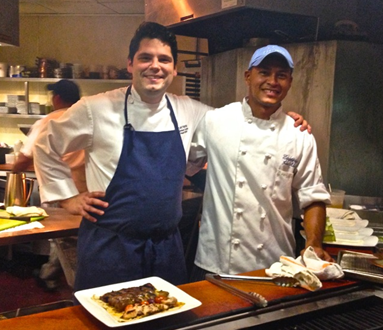 Order up for Head Chef Michael Costa and his team at Zaytinya Many unique wines and spirits from around the Mediterranean are on the agenda. On September 25th from 5 till 7:00 p.m. complimentary tastings will feature Lebanese wines; Turkish wines will be showcased on the 26th; wines from Greece on October 2nd; and spirits distilled from grapes will be sampled on October 3rd.
On Monday, September 30th the “Zaytinya Road Trips 2013” dinner will be led by ThinkFoodGroup’s Wine Director, Lucas Payá, along with Zaytinya’s Beverage Manager, Daniella Senior, who will share highlights of remarkable wine experiences from their recent travels through Greece.
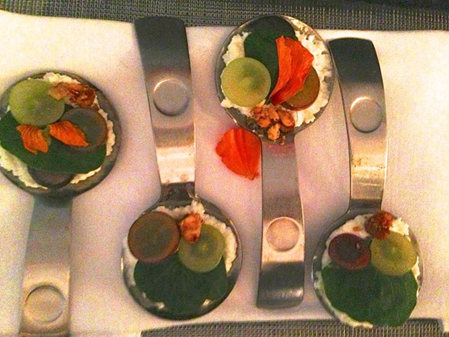 Grapes take a star turn in these delicious nibbles We had a chance to savor a few of the innovative dishes that originate from early culinary traditions and that will be on the menu throughout the festival. Mutancene, is a preparation made with lamb shoulder sourced from Virginia’s Border Springs Farm and calls for braising the lamb in honey and grape vinegar with almonds, dried plums and apricots. This truly is a regal recipe, a version of which was served in the 16th century at the court of Ottoman Sultan, Suleiman the Magnificent.
Prawns Arak, another delicious offering, is prepared with head-on shrimp sautéed in arak, roasted grapes, red Fresno chiles and aromatic herbs. Arak is an aniseed-flavored alcoholic spirit popular in the Middle East. Also on the menu is Muscat Grape Granita, an orange flower scented yogurt espuma with candied orange and lemon verbena.
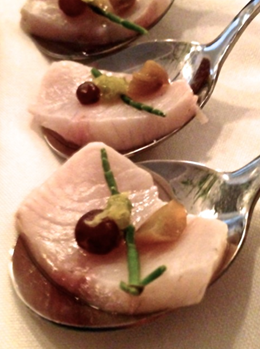 Hamachi crudo topped with grapes and sea beans “There’s More Than One Way to Skinos a Grape” is a whimsical cocktail created for the festival. Skinos is a liqueur made from the resinous sap produced from the mastic tree and used in cooking. Here it is combined with verjus, the juice of unripe grapes, Dolin Blanc Vermouth, Fee Brothers Old-Fashioned Bitters, a lemon twist and a garnish of a frozen peeled grape. Cleopatra would be most pleased.
Festivities conclude October 5th with a Greek Harvest Patio Party that will include live music, grape stomping, a glass of wine and snacks, all for $10.00 pp. For more information visit http://www.zaytinya.com/index.php/about/calendar/grape-festival-at-zaytinya.
Photo credit – Jordan Wright
Cary Pollak for Whisk and Quill
September 12, 2013
Those of you who have enjoyed summertime performances at the Wolf Trap National Park for the Performing Arts here in the Washington, DC area know that enjoying a picnic on the lawn before the show is part of the fun. At one such outing I was commandeered to provide dessert and was eager to bring something both beautiful as well as delicious. The friends I was joining that evening tend to think that the presentation on the picnic table is almost as important as the one on stage. With that challenge in mind I made a large French tarte with freshly baked crust, pastry cream, summer fruits and a shiny apple glaze. This stunning final act is perfect for dining al fresco or at home at a formal dinner party.
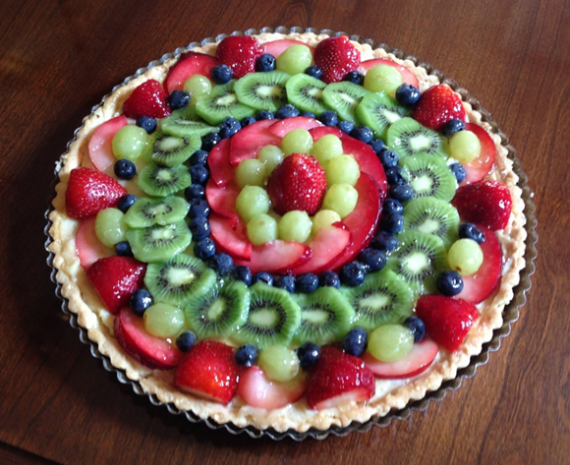 12 ½ inch tart with strawberries, green grapes, red plums, blueberries and kiwi fruit The origin of the modern fruit tart is less than clear, but it is known that French and Italian Renaissance chefs developed several pastry doughs still popular today. The Propre New Booke of Cokery published in England in 1545 contains a recipe for making “shorte paest for tart” that would look familiar to today’s pastry chefs. Most likely the first fruit tart to gain notoriety as an individually named dessert was created by the Tatin sisters for the restaurant in their hotel in the village of Lamotte-Beuvron, France in the late 1800’s. This upside down apple tart with caramelized fruit concealed beneath a pastry crust, was made famous after the sisters’ demise by the iconic Maxim’s in Paris, where it was called for the first time, “Tarte Tatin.”
Fruit tarts can be made in any home kitchen. It’s easier than expected and well worth the effort. You will need a French tart pan with a removable bottom, a stand mixer and a food processor. The electric appliances are not entirely essential in that these tarts were made for decades before such conveniences were invented. For some cooks there is a tactile satisfaction to cutting cold pieces of butter into flour by hand to create the dough, but the speed of an electric food processor transforms the tart making process from daunting to doable.
French tart pans produce impressive results, but they must be handled with care. Always lift them by the edges. The removable bottom makes it easy to pop off the rim and place the tart on a dish when it is ready to be served. But if you attempt to lift the pan by the bottom at any point before that, the rim can slip off and the tart slide to the floor. At that point you could be muttering curses far stronger than “Sacre bleu!”
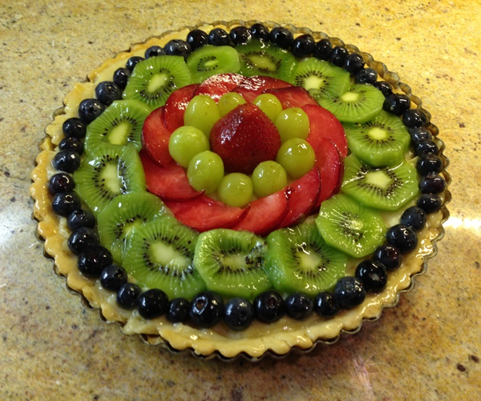 9 ½ inch tart with strawberry, green grapes, red plums, kiwi fruit and blueberries The main types of pastry dough used in French cooking are pâte brisée, pâte sucrée and pâte sablée, all of which consist mostly of butter and flour. The first is a standard pie dough; the second, as the name implies, contains more sugar; and the third is a more coarsely textured dough reminiscent of sand. There are so many variations in the recipes that can be found for each, that the distinctions tend to blur. The following recipe is not definitive and can be tweaked to your liking. It makes enough dough for two 10-inch tart pans.
[color-box]Pâte Sablée
2 ½ cups of all-purpose flour
1 tablespoon of sugar
16 tablespoons of butter, very cold and cut into cubes
1 large egg, stirred slightly to break up the yolk
¼ cup of water
½ teaspoon salt[/color-box]
Preheat oven to 375 degrees. Butter the inside of a tart pan and dust it with flour tapping out any loose flour. Place the dry ingredients into a food processor fitted with the chopping blade and pulse briefly to combine. Add butter and pulse for several seconds at a time until the mixture resembles coarse meal. Add liquid ingredients and process until the dough is formed. Divide the dough into two equal parts, wrap each in plastic wrap and refrigerate for 20-30 minutes.
On a floured board roll out one of the dough portions into a disk one inch larger than the 10-inch tart pan. It is best to use a standard French rolling pin, which is a wooden cylinder 19- or 20-inches long and just under two inches in diameter. It gives greater control and a larger working surface than the more familiar type of rolling pin with the two small handles on either end. The dough can then be transferred to the tart pan by placing the rolling pin in the middle of it, folding it over the pin, then raising it up and lowering it into the pan. Lift up the dough that overlaps the pan a little bit at a time so that you can press the dough into the edge between the bottom and the rim, all around the pan. Make sure that the dough is flush against the rim and of uniform thickness all around. Use a sharp paring knife to trim the dough flush with the edges of the pan.
A common instruction at this point is to line the pan with parchment or wax paper weighted down with pie weights or dried beans and bake for about 20 minutes. Remove paper and weights and continue baking for about 10 minutes until the crust is golden brown. A short cut I prefer starts by making sure the crust is well pricked to allow for steam to escape rather than form bubbles during the baking process. Cut strips of foil into two-inch by six-inch sections. Fold them in half lengthwise and bend them into a curved shape. Place them end to end in upside down “V’s” around the perimeter of the crust, so that they form a loose fitting “tent.” This will prevent the edges of the crust from browning more quickly than the bottom. In about 25 minutes the crust should be uniformly golden brown without the need for a second trip to the oven, but be sure to watch the crust, not the clock. You may have to remove the foil for the last few minutes to make sure the fluted edges are done.
The vanilla pastry cream (crème patissière) is a cooked filling that should be solid enough to support a layer of fruit and glaze. As with French pastry dough the recipes vary from cookbook to cookbook. The one below is a more traditional type in that the starch used is flour. Other recipes use a mixture of flour and cornstarch or cornstarch alone.
[color-box]Vanilla Pastry Cream
5 egg yolks
½ cup of sugar
¼ cup of all-purpose flour
1 ½ cups of milk
2 teaspoons of vanilla extract[/color-box]
Using an electric mixer with a whisk attachment, mix the yolks for a few seconds. Add the sugar, then the flour, and beat to a thick paste. Heat the milk in a pot just until it comes to a boil. Continue beating while pouring the milk slowly into the bowl, and add the vanilla. Transfer the mixture back to the pot and simmer for two minutes, stirring constantly, to cook the flour. Cool the pastry cream by placing it in a bowl and covering the surface with wax paper to prevent the formation of a crust. Refrigerate if you wish to speed up cooling.
Fill the pastry crust with an even layer of pastry cream. Now you are ready for the creative part. You could make a tart that features only your favorite fruit, or you could assemble many colorful fresh fruits. The latter could be used to create a random spattering of different fruits, or a number of sections, each devoted to a single fruit. Better still, find the center point of the tart (with a tape measure if necessary) and build from there. Think in terms of concentric circles and contiguous or overlapping fruits. The tart is your canvas and the fruits are your paints.
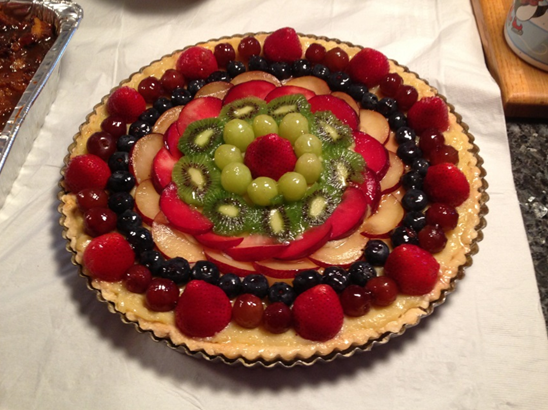 12 ½ inch tart with strawberries, red and green grapes, blueberries, black and red plums and kiwi fruit Speaking of painting, the final step is to brush on a glaze. This preserves the color and freshness of the tart and adds a beautiful sheen. Melt down jelly in a pot with a little water. Let it cool until it is no longer hot, but still liquid enough to be applied with a pastry brush. I like to use apple jelly, but you can also use apricot, which is clear enough in color and light enough in flavor to enhance, rather than compete with the fruits.
A gorgeous fruit tart is something you will want to share with your friends. Don’t be alarmed if you feel a tug of hesitation when guests are ready to cut the first slice. Be sure to snap a picture to immortalize your masterpiece. That way you can preserve your tart for posterity…and eat it too.
 French tart pans, 9 ½ inch and 12 ½ inch diameter Photo Credits: Cary Pollak
Jordan Wright
September 1, 2013
Special to DC Metro Theater Arts, Broadway Stars, and LocalKicks
Casa Luca
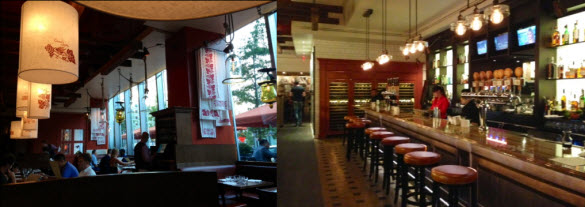 The bar at Casa Luca Fabio Trabocchi insists his new restaurant Casa Luca Vino E Cucina is a tribute to his roots in the Le Marche region, which also happens to be the land of truffles. “I grew up very poor and this is the food we had on our table,” he told me in a recent phone conversation. Now I’m not one to challenge a gentleman’s pentimento, but if you go by the dishes here, you will say the peasants ate very well…very well, indeed. Certainly I did on a recent visit.
Trabocchi who is far and away one of the most respected Italian chefs in the country has opened what he calls a “casual dining” experience, which is to say it is not the fine dining of Fiola, his first restaurant in Washington, DC, nor that of the Medici family table. On the other hand don’t expect massive platefuls of meatballs and spaghetti – – this is not your mamma mia’s kitchen.
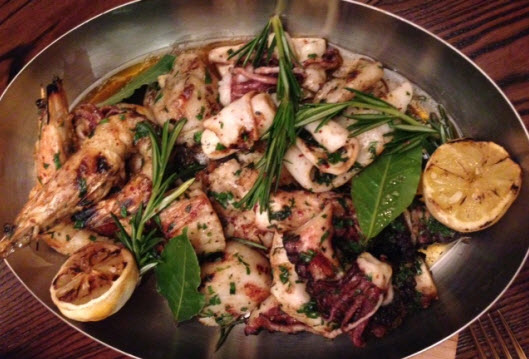 Grigliata Mista di Pesci Soft light bathes the high-ceilinged space, from the pendant lamps to the floor-to-ceiling windows overlooking 11th Street. It is a contemporary Euro vibe with a nod to the past from blowups of old family photographs. Red accent walls and grape motifs dot the room on table runners hanging from wrought iron racks to linen lampshades sporting the restaurant’s logo. Half moon banquettes offer an intimate retreat much like they do at Fiola, while window tables and outdoor seating are cherished spots for people watching.
We cooled our heels with a lovely cocktail from celebrated local mixologist Jeff Faile, who has been jockeying back and forth between the two restaurants as the staff gains their footing.
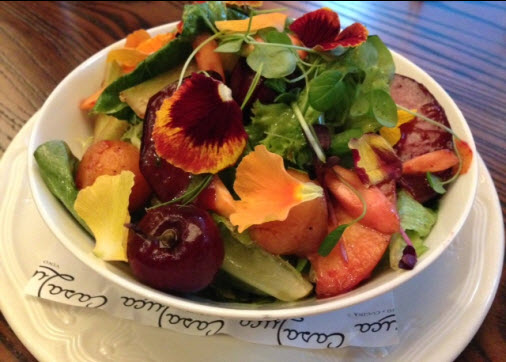 Stone fruit salad from Casa Luca The china here is worth mentioning as it is purposely and charmingly mismatched. While plates range from white china in classic 19th C patterns or 50’s modern, soup vessels are made from old wine bottles and delicate flowered saucers appear to have been plucked straight from auntie’s breakfront. It is what you would expect to see if you were in someone’s home in the country…in Italia, that is.
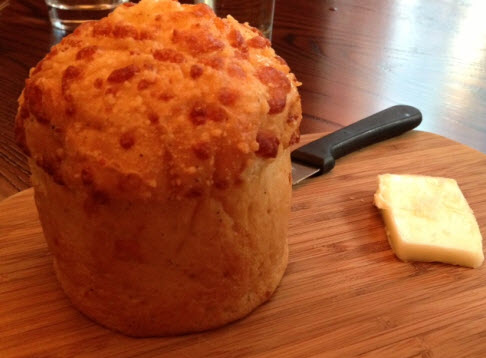 The Marche Classic Cheese Bread with buffalo butter Begin with some bread. It is not to be ignored. The “Marche Classic Cheese Bread with Buffalo Butter” is a rich, glistening, cheesy, crust-topped mega-muffin served with a steak knife and an elongated pat of butter. The butter may be superfluous, but it is certainly the point. Do it justice. I can only assume the buffalo reference comes from the water buffalo from which mozzarella di buffala is made, but I’m a bit fuzzy on the menu’s translation.
Maria Trabocchi, Fabio’s beautiful Spanish wife, created the recipe for the restaurant’s gazpacho, one of the most delectable versions this epicurean has ever lapped up. Garden vegetables are finely diced and crunchy on the bottom half. Then the same combination of tomatoes, peppers, onions and garlic is slightly pureed and floats on top. A tiny pool of aromatic olive oil rests on the surface to smooth out the flavors. It is perfection.
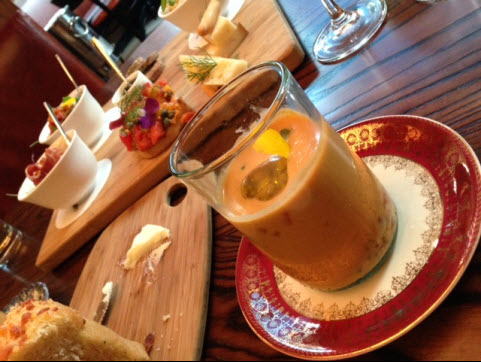 Maria’s gazpacho in foreground There is a listing of piccoletti to tantalize the diner. We could not decide on which alluring small bites to choose from and so requested a smattering of each, including a chunk of manchego in rosemary and olive oil and canestrato pecorino with a few rounds of fennel salami. The cazzimperio is a slice of toasted bread piled high with meltingly ripe tomatoes piled high with capers, fennel sprigs, olives, peppery pansies and a hint of garlic – a veritable blizzard of sensuous flavors. Little cups held jewel-like salads one of sweet corn, prosciutto and mint, another of heirloom tomatoes and stracciatella, the third of burrata and tomatoes with pesto.
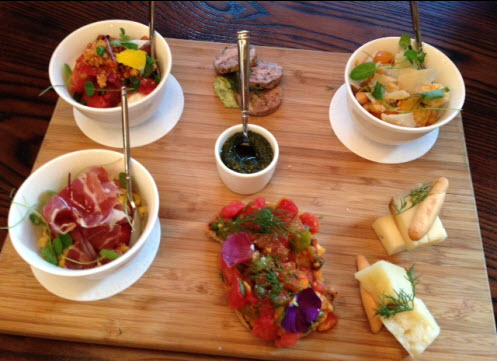 An assortment of piccoletti A salad of tender greens, plums, peaches and cherries arrived adorned with colorful pansies and dressed with a whiff of vinaigrette that spelled orchard meets field in the loveliest way.
If you are looking for Trabocchi’s renowned gingered lobster ravioli, which I have written about before on these pages, you won’t find it here. These are rustic regional pastas fatta in casa. Expect some to be earthy and unrefined like smoked gnocchi with duck ragu and cremini mushrooms – – not terribly summery for my taste but a well known Le Marche dish – – or soupy like Campanelle in Brodetto with prawns. Grilled scottadito, defined as “finger burning” on the menu, are smoky, juicy, fat-laden lamb chops that beg to be picked up by the bone and gnawed over but only if dining al fresco beneath a trellis of grapevines, not supplied here.
Grigliata Mista di Pesci is a dish that embodies summer holidays whiled away along the Italian coast. Mixed grill of locally caught seafood is found most anywhere along the sea, be it Adriatic or Mediterranean. And for me Trabocchi’s way with seafood evoked sun-filled days spent seaside and starry nights of dining on the beach in sight of pastel-colored fishermen’s boats. For this dish gorgeously tender octopus, briny head-on shrimp, golden-seared sea scallops and the daily catch are grilled over a wood fire and tossed with fresh bay leaves, rosemary, parsley, olive oil and charred lemon halves. Ahhhh. La dolce vita! Could life be any sweeter than this?
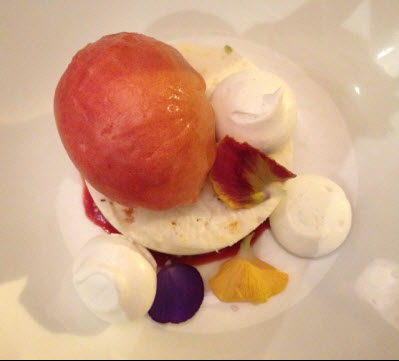 Sicilian Cassata at Casa Luca After much to-ing and fro-ing we settle on three desserts (all in the name of research, dear readers, because we are stuffed to the gills). We are steered towards the Ciambellone di Nonna Palmina, a hazelnut coffee cake sounding more like a breakfast treat. The surprising combination of caramel gelato and vin cotto to pour over the cake, assure us it is not. Sicilian Cassata is a colorful concoction of pistachio and orange semifreddo, a firm ice cream, with baby meringues and strawberry-campari sorbetto decorated with the ubiquitous pansies as is the Luca Macedonia –stone fruits and the sorbetto of the day. Each dish is beautiful in a carefree way as if tossed together with flower petals gleaned from the kitchen garden. If this is how the peasants are eating these days, I wonder what it’s like to be a duke!
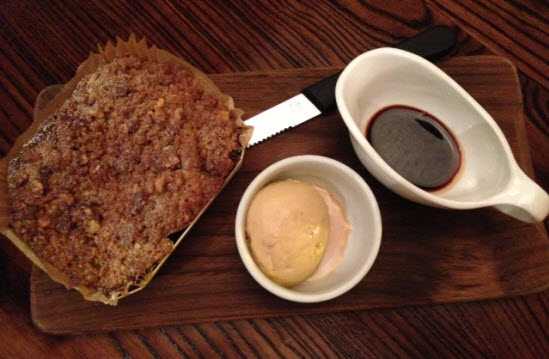 Hazelnut Coffee Cake with caramel gelato and vin cotto Casa Luca adheres to its casual definition by offering nearly two dozen wines at $28.00 a bottle with a few selections by the glass or carafe including the Tuscan Donna Laura Sangiovese the restaurant keeps on tap. But go for the limoncello with strawberry, one of four varieties of vin dolce, or one of five grappas from Poli, produced by a 5th century Veneto family since the 1800’s. And buon appetito!
Get Your Mad Men On
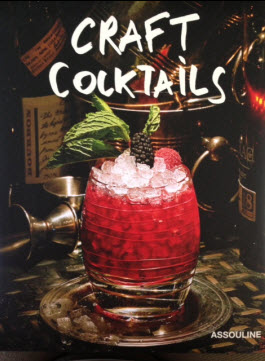 Photo credit – Harald Gottschalk Craft Cocktails is writer Brian Van Flandern’s latest homage to the hand-crafted cocktails enjoyed pre-Prohibition – – a period between 1920 and 1933 when talented bartenders fled to Europe in droves, Eliot Ness and “The Untouchables” chased mobsters and moonshiners, and a hatchet-wielding Carrie Nation ransacked her way into speakeasies all under the guise of the Volstead Act banning “intoxicating liquors’ throughout the U.S. Given today’s fascination with these throwback cocktails, it’s difficult to fathom what it was like to live in the shadows just to get a little drinkie pooh.
In his follow-up collection Van Flandern, who has been named one of the “Top Ten Hotel Bartenders in the World” by Travel and Leisure Magazine, selects a few fellow bartenders from New York’s top craft cocktail lounges to join in the fun by contributing some of their recipes to the “mix”. Death & Co., PDT (Please Don’t Tell), Employees Only and Clover Club in Brooklyn are the four bars that meet his approval for innovative drinks, retro-chic ambiance and high standards of service. Mr. Van Flandern is very particular…and that should come as no surprise to those who have sampled his creations at the Bemelmans Bar at The Carlyle Hotel; The World ship, the private residential luxury liner that plies the high seas; and Per Se, where he fine tuned his art at Thomas Keller’s Michelin three-starred restaurant in New York City.
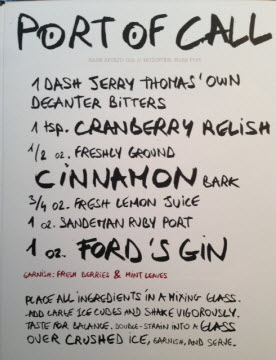 Recipe for “Port of Call” cocktail by Brian Van Flandern Filled with quirky-charming hand-written recipes naming the exact liquor brands along with specific instructions on how to achieve the perfect drink, Craft Cocktails is written as a companion guide to Vintage Cocktails, an earlier book in the same vein, that featured a revival of elegant handmade cocktails by the noted mixologist. Lavish photographs of the finished and garnished cocktails in period settings and in Baccarat crystal glassware are by Harald Gottschalk.
So get your shakers and stirrers out, and as the uncompromising Mr. Van Flandern would say, “Bottoms up!”
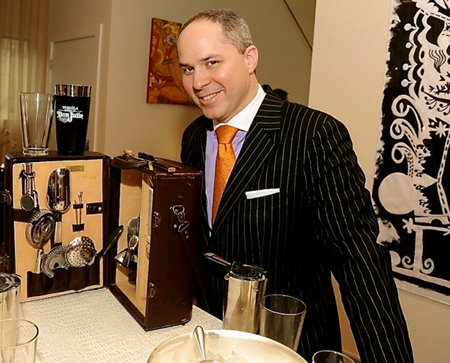 The debonair Brian Van Flandern with his cocktail kit Photos by Jordan Wright
Jordan Wright
August 28, 2013
Special to DC Metro Theater Arts, Broadway Stars, and LocalKicks
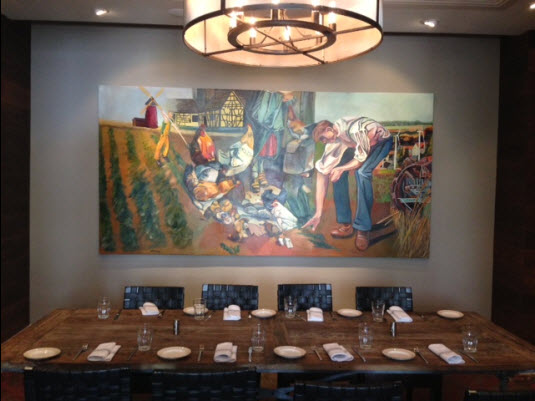 One of the private dining rooms. Painting by Brian T. Dang Uber Restaurateur Ashok Bajaj Has a New Baby
When it comes to cooking up success, Ashok Bajaj has a formula that could well be called the ‘ultimate dish’. It’s simple, really. Hire a talented chef, train your staff to a fare-thee-well, commission a trendy architect to design a stylish restaurant, and put it in a high-end location with plenty of foot traffic. What could go wrong? Not a blessed thing, as it turns out.
Bajaj’s latest foray into downtown DC is nopa Kitchen+Bar, whose floor-to-ceiling windows face out onto the exquisite Greek Revival façade of the stately National Portrait Gallery. It’s an area he’s already dominated with 701, Rasika, Rasika West End, Ardeo + Bardeo, Bibiana Osteria-Enoteca, The Oval Room and The Bombay Club, his first outpost in Washington.
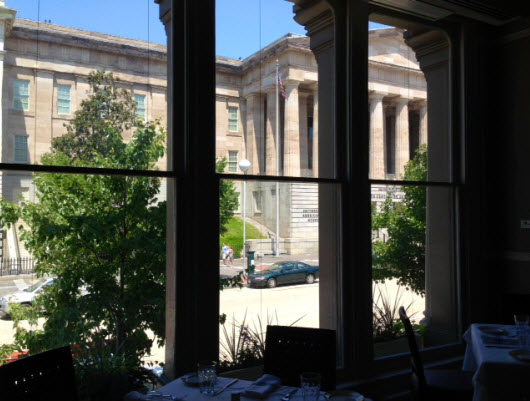 A dining room with a view from nopa Kitchen+Bar Over the past twenty-five years, Bajaj, a transplant from New Delhi whose training at the Taj Hotels, Resorts and Palaces prepared him well for DC’s kingmakers, has been showered with umpteen awards from industry titans to magazine editors, who track his latest ventures like Bengal tigers. Earlier this year Bajaj was named “Restaurateur of the Year” by Washingtonian Magazine, an accolade bested only by his recognition by the James Beard Foundation, Forbes, CNN and GQ Magazine.
So what’s nopa got that sets it apart from the others? To begin with nopa’s Executive Chef, Canadian Greg McCarty, who has brought along his impressive resumé. Before landing in DC he spent six years alongside celebrated chef, Jean-George Vongerichten at the luxurious Bahamian restaurant Dune, later trotting off to Manhattan to open Nobu 57 and assisting renowned restaurateur Drew Nieporent on a number of special projects.
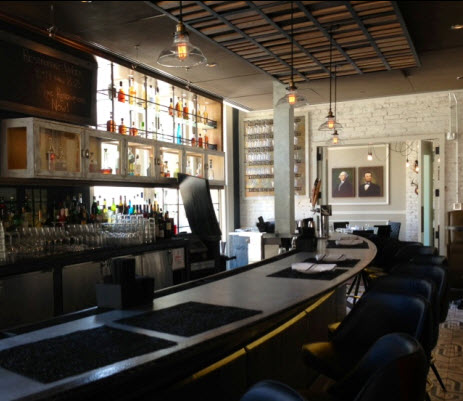 The zinc bar Described as an American brasserie, nopa’s fresh decor has beautifully transformed its earlier incarnation as Zola. Martin Vahtra, the resto’s swank designer has swept away the heavy velvet drapes to reveal a series of light-filled dining rooms with white-washed brick walls, rustic wooden beams, and a black-and-white original mosaic tiled floor beside the zinc bar to reveal a unique space that can now highlight the historic building’s distinctive architectural elements.
Let’s have a cocktail, shall we? The bar’s designer cocktails are surprisingly well priced at ten dollars and list six under two categories “The Classics” and “Signature Cocktails”. “Blood and Sand” is an updated version of the original using Black Bottle Scotch Whiskey with Luxardo Cherry Liqueur, Dolin Rouge Vermouth and blood orange puree and “Red Envy” is an exotic concoction of El Dorado Rum, Heitz Cellar Ink Grade Port from the Napa Valley, lime and Fee Brothers Chocolate Bitters. But the warm day spells gin to me, and the “800 F & Tonic” sports Plymouth Gin, house-made tonic and lavender with a ginger infusion to spice it up.
Because of its Penn Quarter proximity to the International Spy Museum and other local attractions, the menu ranges from family friendly choices like burgers and vegetarian options like the veggie bánh mi sandwich with cauliflower purée and a fresh herb salad, to fine dining and designer drinks. At a recent lunch I found some hits and a few misses. Foie gras terrine with a swoosh of carrot ginger purée was addicting, but the bluefish paté was disappointing, the negligible amount of fish in the spread renders the whole thing inconsequential and its accompanying triangles of earthy Russian-style black bread become far too ponderous a vehicle, especially when the bread basket has such alluring choices.
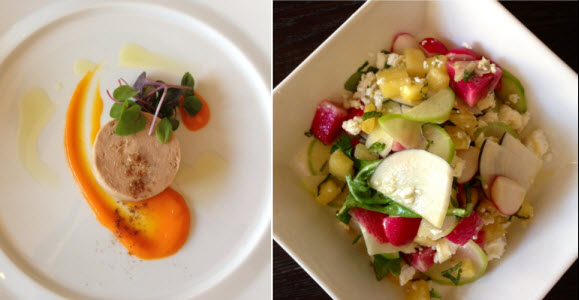 Nopa – Foie gras with carrot ginger swoosh – Spring radish salad with pineapple, mint and feta Gazpacho seems to be the only soup offered. Unfortunately it was blended into the consistency of a breakfast smoothie and the crunch of summer vegetables unexpressed. But crispy soft shell crab with avocado basil purée was precisely on point as was the sprightly radish salad with chunks of pineapple, feta and mint.
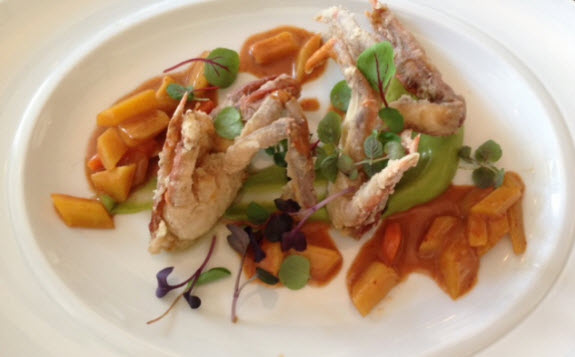 Soft shell crab with avocado basil purée When it comes to fish the chef treats it with a gentle respect, no doubt from his days in the Bahamas preparing fresh catch with a French chef, and a glazed Chilean sea bass with tender baby eggplant and wasabi pea mash was everything one would hope it would be – the sweet taste of the fish balanced against smoky soft eggplant and a hint of fire from the Japanese horseradish.
At this point dessert beckoned and it was, well, cute! Tasty fried cherry hand pies with crushed raspberry icing – the sort of thing grandma would toss into a cast iron skillet and a creamy dreamy version of banana pudding that was reminiscent of a church picnic.
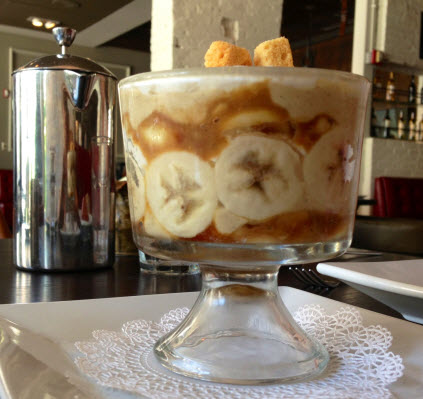 The creamy dreamy banana pudding For Ashok Bajaj the formula is still working.
Photo credits – Jordan Wright
|








































